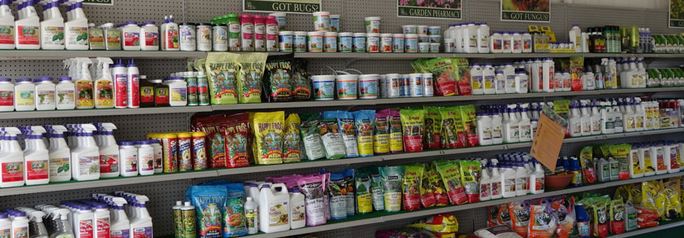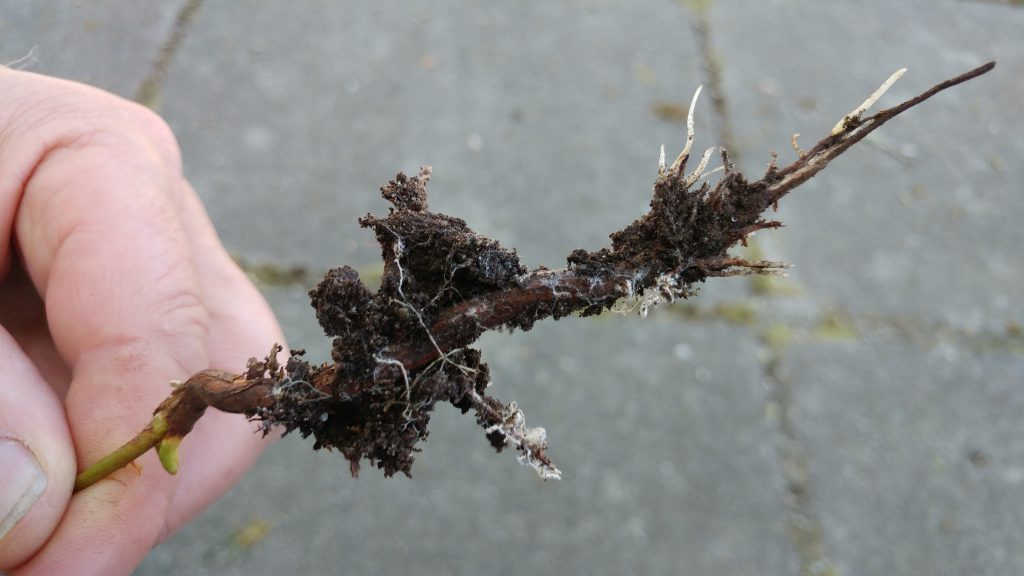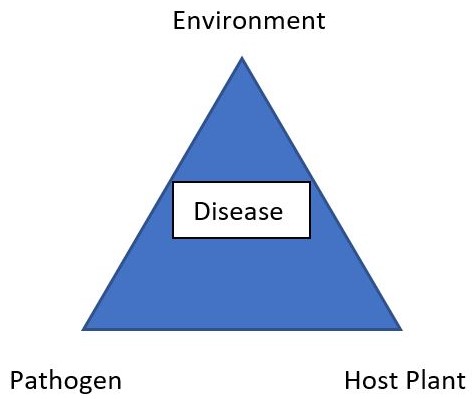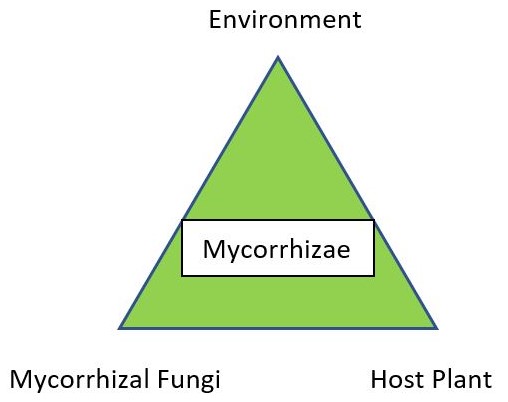
The movie “Field of Dreams” is a family favorite – we love how baseball and the supernatural are interwoven to create a great story. If you haven’t seen the movie, you should – and for those of you that have, you know why it was important for Ray to build the baseball field. Like the magic that unfolded once that physical space was provided, botanical magic emerges from garden soils that support mycorrhizal life. Garden product peddlers have taken advantage of the scientifically-established relationship between plants and mycorrhizal fungi by selling inoculants. And gardeners tend to focus on which of the many brands of inoculants to buy, rather on questioning their efficacy.

I’ve attached a link to my peer-reviewed fact sheet on mycorrhizae for a more in-depth discussion about this symbiotic relationship, but the bottom line is this: inoculants don’t work. To understand why, we need to consider a modified version of the disease triangle. Many gardeners are familiar with this concept, which depicts the three criteria needed for plant disease to manifest: the presence of the pathogen, the presence of a host plant, and environmental conditions conducive to pathogen growth. Pathogen spores are EVERYWHERE in landscape and garden soils – they just aren’t activated unless their host is present and environmental conditions allow their germination. Likewise, mycorrhizal spores are EVERYWHERE in landscape and garden soils. We can make a mycorrhizal triangle to visualize the three criteria for needed for mycorrhizae to develop.
While our understanding of mycorrhizal relationships continues to expand, we do know some of the environmental factors needed for successful inoculation:
- Soil oxygen. Mycorrhizal fungi are aerobes, meaning they are active when sufficient oxygen is present.
- Woody debris on the soil surface. Mycorrhizal species are also decomposers of woody material. There is increasing evidence that a natural woody mulch (not sawdust, not bark) is required for mycorrhizal establishment. Fungal hyphae colonize the debris, extract nutrients, and transport them to their host’s roots. Arborist wood chips are an ideal mulch in this regard as they absorb water and provide an ideal substrate for hyphal development.
There is a robust body of peer-reviewed research conclusively demonstrating that commercial inoculants applied to plants in landscaped soils have no substantial effect on the development of mycorrhizae. This lack of efficacy has induced some inoculant manufacturers to add fertilizer, especially nitrogen, to increase plant growth and fool consumers into thinking the inoculant was responsible.



The image on the left is the label from a mycorrhizal inoculant. Close inspection (middle image) reveals addition of a fertilizer, which is identical in NPK content to a fish fertilizer (right image).
And here is the lesson “Field of Dreams” provides: if you build it, they will come. Build a healthy soil by mulching with a thick layer of arborist wood chips. Not only do they provide nutrients and absorb water, but their presence reduces soil compaction and increases aeration. You can be assured your plants will be successfully inoculated with your soil’s native mycorrhizal species.



Excellent article on mycorrhizae and the trick being used to sell people what they don’t need. Now i need to find a local source for arborist wood chips. Thank you, Linda!
Thanks! And try using chipdrop.com if you have trouble finding chips.
Contact Chip Drop- a place where arborists pay a small fee to get the address of homeowners who want free wood chips- it save a trip to the dump.
You are more likely to get chips if you pay a nominal amount. Tree services must pay $20 to use the site, so offering at least that amount is more likely to work than trying to get them for free.
Is there a minimum depth for the chip layer for Mycorrhizae to develop?
Not really…but if you use less than 4″ you may have weed problems.
Thanks!
I live in Georgia and was just pricing products to encourage mycorrhizae. I am glad I read this article. My question is, do you feel the same way about biochar? Does it do anything? A big Atlanta-based tree service company uses it..
Please give this fact sheet a read. Bottom line – it’s not going to be very useful except in very limited and artificial conditions.
The link says bc is useful to increase drought tolerance. Disagree?
You mean the link to my fact sheet? It doesn’t say to add mycorrhizae for drought tolerance – it says that mycorrhizal plants can be more drought tolerant.
I prefer a thinner mulch layer (less than 2″) for my clients in order to more mimic Nature, and yes, I’m ok with a little extra weeding…
Great research. Thanks.
There really isn’t a set amount that nature creates in terms of mulch. It’s completely dependent on the environment. For instance, mature forests have duff layers that are many layers deep. Grasslands, with less annual rainfall, have few trees and much shallower mulch layers. Deeper layers also conserve more moisture – which given our changing climate is not a bad idea.
I’m only in a community garden that does not allow chipdrop. If there a commercial product that will work as well?
There really isn’t. You might be able to find bagged arborist chips at a nursery or garden center. But be sure it’s not processed wood, or worse yet bark. Too bad your community garden isn’t up on the science behind using wood chips. It would do their soil and plants a world of good.
Thank you for this info! Starting my native California garden and thought micorhizzae innoculant was important to buy. Nevermind!
fungi that break down wood is different than mycorrhizae fungi, right? so why should we assume that the fungi from wood chips transfers or ‘brings in’ mycorrhizae ?
Mycorrhizal fungi are also decomposers; both host trees and decomposing wood are required for optimal mycorrhizal growth. Arborist wood chips are full of these mycorrhizal spores, and even if they weren’t they would be quickly colonized by these species.
Thank you for the clarification. Just to understand this further, mycorrhizal spores are assumed to be part of the decomposing fungal growth on wood chips as a general rule of thumb? both endo and ecto? I use wood chips all the time in my perennials spaces, but I am trying to figure out how to get mycorrhizal spores integrated further into my annual beds. Wood chips in the aisles is a pain in the but and has it’s own set of challenges, so I would like to know the best way. I was thinking a light integration of mycorrhizal inoculants (cultivated onsite or purchased) into my seed starting mix, so then every transplant is essentially an inoculant when it goes out to the garden. Also why do you say ‘bark is bad’ above? Lots of people are pushing ramial wood chips which have a higher bark/cambium to lignin ratio…, but it sounds as if you may disagree? thanks again.
I don’t suppose mycorrhizal spores are always on mulch. That is a separate thing. Spores are in the air and fall on the mulch. No bark. NO energy for microbes in bark, It is too slow to break down and has very little energy for microbes. Mycorrhizae will find your chips you don’t have to add them
Before I knew anything at all about mycorrhizal spores, I did discover the “power” within wood chips after bushfire salvage operations left tons of this material along roadsides for free collection. For some reason (yet to be recalled) I spread a garbage bin of wood chips around the base of a young eucalyptus tree. This tree then proceeded to outstrip the growth of other adjacent trees of similar age and size by 40%.
Further applications of this magic “fertiliser” revealed that this treatment was very effective in reversing tree dieback. However there was one condition, the wood chips had to match the species of the ailing tree.
Further thought on this matter prompted the harvesting of ryegrass with a lawn mower and catcher. The ryegrass biomass was spread liberally over numerous grass species in another paddock. Ryegrass responded with considerable vigour to this treatment, however there was no such response from any of the other grass species.
I am sure there must be some unseen biological thread in all of this. Mycorrhizal fungi comes to mind.
There’s no evidence that the mulch species has to match the living plant species. The plants are benefitting from the mycorrhizae common to the region.
Great article on innoculants being clever marketing, great to get the word out there! I’m wondering with the wood chip if it should be aged for a year or more to stop nitrogen lock up in the soil? I’ve heard that fresh wood chip can cause this problem, what are your thoughts on this?
Nitrogen “lock up” isn’t an issue if the chips are kept on the soil surface. Don’t till them in and there’ll be no issues.
I have read that chip drop does not allow you to discriminate which type of chips they deliver. Is it true that eucalyptus,walnut and california bay chips contain chemical compounds that inhibit plant growth and should not be used? If that is the case, how will i even know and what will i do with 10 yards of chips if i have the misfortune to receive a drop of those?
You can specify trees you don’t want in your drop. But let me assure you that there are no trees that produce chips which will hurt plant growth.
For more information on the myth of allelopathy in the garden, I’ve published this fact sheet: https://www.researchgate.net/publication/333516407_DO_BLACK_WALNUT_TREES_HAVE_ALLELOPATHIC_EFFECTS_ON_OTHER_PLANTS_HOME_GARDEN_SERIES